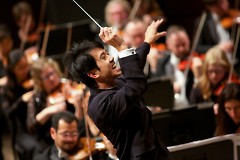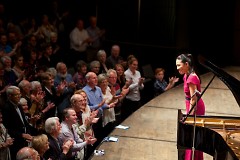One of the great pleasures of art is the delights and discoveries you encounter along the way.
Grand Rapids Symphony’s performance of Rachmaninoff’s Rhapsody on a Theme of Paganini easily transported its listeners to another time and place. How could it not with the elegant and engaging Joyce Yang at the piano, sailing the ship, and the irrepressible guest conductor Perry So, navigating the voyage?
No doubt, the music that led Christopher Reeve to fall in love with Jane Seymour in the 1980 film, Somewhere in Time, artfully played by a Van Cliburn Competition medalist, was the draw to the performance by the Grand Rapids Symphony in DeVos Performance Hall on Friday, October 7.
The surprising discovery of the evening was Polish composer Witold Lutosławski’s appealing and challenging Concerto for Orchestra. The Grand Rapids Symphony's performance was nothing short of magnificent.
The second concert in the 2016-17 Richard and Helen DeVos Classical Series, which repeated on Saturday, October 8, was destined to be a big hit from the downbeat of Antonin’ Dvorak’s Carnival Overture, an earthy, energetic concert opener, that drew applause and actual cheers from the audience of 1,017.
Perry So, who guest conducted the Grand Rapids Symphony in March, returned full of vim and vigor for the evening. It takes only a few minutes to see that the Hong Kong-born conductor likes the orchestra, and the orchestra likes him. That mattered in the Concerto for Orchestra.
Bela Bartok’s Concerto for Orchestra, composed in 1943, is the best-known work in the form that essentially calls for every section and every instrument in the ensemble to give a virtuosic performance. It’s a mostly modern approach because only in modern times could orchestras pull it off.
Lutosławski, like nearly all of his contemporaries in communist-dominated Eastern Europe, suffered much oppression from the state and rose above it. Somewhat subversively, the composer drew heavily upon Polish folk melodies and reached back to the Baroque for such compositional techniques and forms as the passacaglia, toccata and chorale to work his musical mischief.
Taken together, between melodies easily grasped and familiar forms, Lutosławski offers listeners an unobstructed view of the mettle of the ensemble performing it. The power of the Grand Rapids Symphony’s brass, the agility of its woodwinds, the precision of its percussion and the sonorities of orchestra strings were on full display, and it was a wonder to behold for an entire 30 minutes.
Conductor Perry So commanded the podium and led the Grand Rapids Symphony in a brilliant performance. An arching opening gave way to an airy, almost unworldly scherzo and then to an intense, brooding chorale with a dazzling finish. Through layers of complexity at times as sudden as an explosion or as gentle as the flutter of a butterfly’s wings or as exhilarating as a plunge over a cliff, conductor and orchestra gave a sensational account.
Pianist Joyce Yang, who first appeared with the Grand Rapids Symphony in 2015, returned with music that served as the soundtrack of her own personal love story. While performing “Rhapsody in the Theme of Paganini” with the Alabama Symphony Orchestra in 2013, she met the orchestra’s assistant principal bass player. Long story short, they were married in August.
In Grand Rapids, it was down to business for the Silver Medalist at the 2005 Van Cliburn International Piano Competition.
The Korean-American pianist is at once cerebral and passionate at the piano. Though intense or effervescent when called upon, the added force of expression doesn’t interfere with the clarity of her lines. The sheer variety of the first dozen and a half variations proved Yang’s ability to communicate effectively in any musical situation.
The young pianist and young conductor weren’t always in precise lockstep. But they corrected quickly.
Most everyone’s favorite passage is the achingly gorgeous 18th variation. Between Yang’s intimate introspection and the light, floaty accompaniment that So drew from the orchestra, it was ravishingly beautiful.
Six more variations of increasing complexity made for a wild ride in a fast machine that left the audience roaring its approval. Yang, clearly delighted, offered as an encore a gently, sweet performance of Alberto Ginastera’s “Dance of the Beautiful Maiden” from his set of Three Argentine Dances, written just three years after Rachmaninoff’s Rhapsody, but half a world apart.
Just before the Concerto for Orchestra, the second half opened with Bedrich Smetana’s Overture to The Bartered Bride. It’s a comic opera, but programming it before the Lutosławski was no laughing matter. It’s a heavy burden for the strings under any circumstances. You have to admire how they pulled it off and came back for more.
Next up for the Grand Rapids Symphony in DeVos Performance Hall
- DreamWorks Animation in Concert - Movie clips and live music from films including "Shrek," "How to Train Your Dragon" and "Kung Fu Panda," 8 p.m. Saturday, Oct. 22.
- Tchaikovsky Violin Concerto - Music director Marcelo Lehninger welcomes guest violinist Philippe Quint for music including Rachmaninoff's Symphony No. 20, 8 p.m. Friday and Saturday, Oct. 28-29
- ET: The Extraterrestrial - The full-length 1982 Steven Spielberg film plus live music, 8 p.m. Friday and Saturday, Nov. 4-5, and 3 p.m. Sunday, Nov. 6.
- Lockington Conducts Dvorak - Music director laureate David Lockington leads the orchestra in Dvorak's Symphony No. 6 plus the world premiere of "Gathering Sunset" by Jeremy Crosmer. Grand Rapids Symphony Chorus and soloists join the orchestra for Ralph Vaughan Williams' Dona Nobis Pacen.
- Call (616) 454-9451 ext. 4 or go online to grsymphony.org
The Rapidian, a program of the 501(c)3 nonprofit Community Media Center, relies on the community’s support to help cover the cost of training reporters and publishing content.
We need your help.
If each of our readers and content creators who values this community platform help support its creation and maintenance, The Rapidian can continue to educate and facilitate a conversation around issues for years to come.
Please support The Rapidian and make a contribution today.



